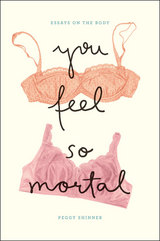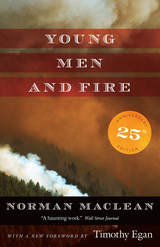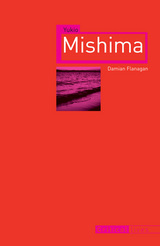849 books about Literary Figures and 3
start with Y
849 books about Literary Figures and 3
849 books about Literary Figures
3 start with Y start with Y
3 start with Y start with Y

You Feel So Mortal
Essays on the Body
Peggy Shinner
University of Chicago Press, 2014
Feet, bras, autopsies, hair—Peggy Shinner takes an honest, unflinching look at all of them in You Feel So Mortal, a collection of searing and witty essays about the body: her own body, female and Jewish; those of her parents, the bodies she came from; and the collective body, with all its historical, social, and political implications. What, she asks, does this whole mess of bones, muscles, organs, and soul mean? Searching for answers, she turns her keen narrative sense to body image, gender, ethnic history, and familial legacy, exploring what it means to live in our bodies and to leave them behind.
Over the course of twelve essays, Shinner holds a mirror up to the complex desires, fears, confusions, and mysteries that shape our bodily perceptions. Driven by the collision between herself and the larger world, she examines her feet through the often-skewed lens of history to understand what makes them, in the eyes of some, decidedly Jewish; considers bras, breasts, and the storied skills of the bra fitter; asks, from the perspective of a confused and grieving daughter, what it means to cut the body open; and takes a reeling time-trip through myth, culture, and history to look at women’s hair in ancient Rome, Laos, France, Syria, Cuba, India, and her own past. Some pieces investigate the body under emotional or physical duress, while others use the body to consider personal heritage and legacy. Throughout, Shinner writes with elegance and assurance, weaving her wide-ranging thoughts into a firm and fascinating fabric.
Turning the category of body books on, well, its ear, You Feel So Mortal offers a probing view of our preoccupation with the body that is both idiosyncratic and universal, leaving us with the deep satisfaction of our shared humanity.
Over the course of twelve essays, Shinner holds a mirror up to the complex desires, fears, confusions, and mysteries that shape our bodily perceptions. Driven by the collision between herself and the larger world, she examines her feet through the often-skewed lens of history to understand what makes them, in the eyes of some, decidedly Jewish; considers bras, breasts, and the storied skills of the bra fitter; asks, from the perspective of a confused and grieving daughter, what it means to cut the body open; and takes a reeling time-trip through myth, culture, and history to look at women’s hair in ancient Rome, Laos, France, Syria, Cuba, India, and her own past. Some pieces investigate the body under emotional or physical duress, while others use the body to consider personal heritage and legacy. Throughout, Shinner writes with elegance and assurance, weaving her wide-ranging thoughts into a firm and fascinating fabric.
Turning the category of body books on, well, its ear, You Feel So Mortal offers a probing view of our preoccupation with the body that is both idiosyncratic and universal, leaving us with the deep satisfaction of our shared humanity.
[more]

Young Men and Fire
Twenty-fifth Anniversary Edition
Norman Maclean
University of Chicago Press, 2017
A devastating and lyrical work of nonfiction, Young Men and Fire describes the events of August 5, 1949, when a crew of fifteen of the US Forest Service’s elite airborne firefighters, the Smokejumpers, stepped into the sky above a remote forest fire in the Montana wilderness. Two hours after their jump, all but three of the men were dead or mortally burned. Haunted by these deaths for forty years, Norman Maclean puts together the scattered pieces of the Mann Gulch tragedy in Young Men and Fire, which won the National Book Critics Circle Award.
Alongside Maclean’s now-canonical A River Runs through It and Other Stories, Young Men and Fire is recognized today as a classic of the American West. This twenty-fifth anniversary edition of Maclean’s later triumph—the last book he would write—includes a powerful new foreword by Timothy Egan, author of The Big Burn and The Worst Hard Time. As moving and profound as when it was first published, Young Men and Fire honors the literary legacy of a man who gave voice to an essential corner of the American soul.
Alongside Maclean’s now-canonical A River Runs through It and Other Stories, Young Men and Fire is recognized today as a classic of the American West. This twenty-fifth anniversary edition of Maclean’s later triumph—the last book he would write—includes a powerful new foreword by Timothy Egan, author of The Big Burn and The Worst Hard Time. As moving and profound as when it was first published, Young Men and Fire honors the literary legacy of a man who gave voice to an essential corner of the American soul.
[more]

Yukio Mishima
Damian Flanagan
Reaktion Books, 2014
The most internationally acclaimed Japanese author of the twentieth century, Yukio Mishima (1925–70) was a prime candidate for the Nobel Prize. But the prolific author shocked the world in 1970 when he attempted a coup d’état that ended in his suicide by ritual disembowelment. In this radically new analysis of Mishima’s extraordinary life, Damian Flanagan deviates from the stereotypical depiction of a right-wing nationalist and aesthete, presenting the author instead as a man in thrall to the modern world while also plagued by hidden neuroses and childhood trauma that pushed him toward his explosive final act.
Flanagan argues that Mishima was a man obsessed with the concepts of time and “emperor,” and reveals how these were at the heart of his literature and life. Untangling the distortions in the writer’s memoirs, Flanagan traces the evolution of Mishima’s attempts to master and transform his sexuality and artistic persona. While often perceived as a solitary protest figure, Mishima, Flanagan shows, was very much in tune with postwar culture—he took up bodybuilding and became a model and actor in the 1950s, adopted the themes of contemporary political scandals in his work, courted English translators, and became influenced by the student protests and hippie subculture of the late 1960s. A groundbreaking reevaluation of the author, this succinct biography paints a revealing portrait of Mishima’s life and work.
Flanagan argues that Mishima was a man obsessed with the concepts of time and “emperor,” and reveals how these were at the heart of his literature and life. Untangling the distortions in the writer’s memoirs, Flanagan traces the evolution of Mishima’s attempts to master and transform his sexuality and artistic persona. While often perceived as a solitary protest figure, Mishima, Flanagan shows, was very much in tune with postwar culture—he took up bodybuilding and became a model and actor in the 1950s, adopted the themes of contemporary political scandals in his work, courted English translators, and became influenced by the student protests and hippie subculture of the late 1960s. A groundbreaking reevaluation of the author, this succinct biography paints a revealing portrait of Mishima’s life and work.
[more]
READERS
Browse our collection.
PUBLISHERS
See BiblioVault's publisher services.
STUDENT SERVICES
Files for college accessibility offices.
UChicago Accessibility Resources
home | accessibility | search | about | contact us
BiblioVault ® 2001 - 2024
The University of Chicago Press









